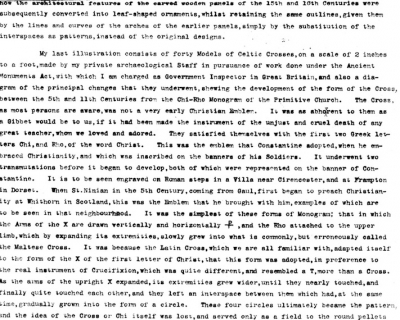To search the RPR site click here
This is an extract from a much longer talk, the full form of which is given here, given by Pitt-Rivers at Blackmore Museum, Salisbury in 1889-90:
... My last illustration consists of forty Models of Celtic Crosses, on a scale of 2 inches to a foot, made by my private archaeological Staff in pursuance of work done under the Ancient Monuments Act, with which I was charged as Government Inspector in Great Britain, and also a diagram of the principal changes that they underwent, shewing the development of the form of the Cross, between the 5th and 11th Centuries from the Chi-Rho Monogram of the Primitive Church. The Cross, as most persons are aware, was not a very early Christian Emblem. It was as abhorrent to them as a Gibbet would be to us, if it had been made the instrument of the unjust and cruel death of any great teacher, whom we loved and adored. They satisfied themselves with the first two Greek letters Chi, and Rho, of the word Christ. This was the emblem that Constantine adopted, when he embraced Christianity, and which was inscribed on the banners of his Soldiers. It underwent two transmutations before it began to develop, both of which were represented on the banner of Constantine. It is to be seen engraved on Roman steps in a Villa near Cirencester, and at Frampton in Dorset. When St Ninian in the 5th Century, coming from Gaul, first began to preach Christianity at Whithorn in Scotland, this was the Emblem that he brought with him, examples of which are to be seen in that neighbourhood. It was the simplest of these forms of Mongram; that in which the Arms of the X are drawn vertically and horizontally [drawing] and the Rho attached to the upper limb, which by expanding the extremities, slowly grew into what is commonly, but erroneously called the Maltese Cross. It was because the Latin Cross, which we are all familiar with, adapted itself to the form of the X of the first letter of Christ, that this form was adopted, in preference to the real instrument of Crucifixion, which was quite different, and resembled a T, more than a Cross. As the arms of the upright X expanded, its extremities grew wider, until they nearly touched, and finally quite touched each other, and they left an interspace between them which had, at the same time, gradually grown into the form of a circle. These four circles ultimately became the pattern, and the idea of the Cross or Chi itself was lost, and served only as a field to the round pellets which had been the interspaces. Finally the Latin form of Cross, which had developed elsewhere, was introduced into the Celtic Church, probably about the time, when the Celtic Cross became subject to Rome, thereby adapting it to the doctrine of the Atonement, which had crept into the Christian Belief, and by which the Instrument of Death had become also the instrument of our Redemption, and on that account a thing to be worshipped. When this Latin Cross was introduced, for the first time, into Scotland [insert] where the expanded Chi only had previously been used [end insert], they added oblong arms to the four extremities of the Chi, so as to form it into the shape of the Latin Cross, whilst retaining the Chi form in the centre, thereby forming what I call the Chi-Cross, which is the peculiar feature of the Celtic Cross, and is found nowhere else in the world.
But the four circular interspaces of the old Chi were not forgotten, and they continued to use them in the intervals between the arms of the Latin Cross. Finally, upon very rude Crosses, were [sic - ?where] time and skill in carving were not to be obtained, they scamped [1] the four circular bosses, which were difficult to make, and replaced them by four small Crosses, which were easily scratched or rubbed upon the stone, and which still retained the same places in the intervals between the arms of the Latin Cross. Here we have an example of what I previously alluded to, of simpler forms being sometimes introduced during the decay of an Art. Some persons supposing that because the four Crosses are rude forms easily made, and always incised, and not raised like the bosses, they must be of earlier construction, but I believe that, being merely substitutes for the circular bosses, and always occurring in the exact place of them, they were of latter date, though of ruder workmanship. ...
AP 2011




